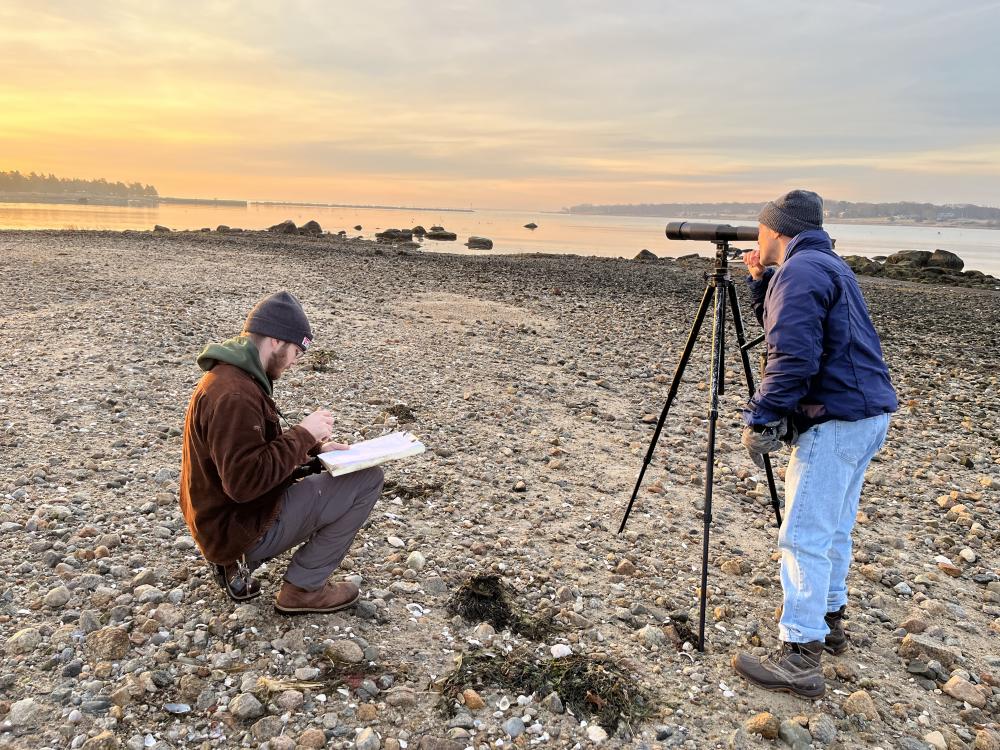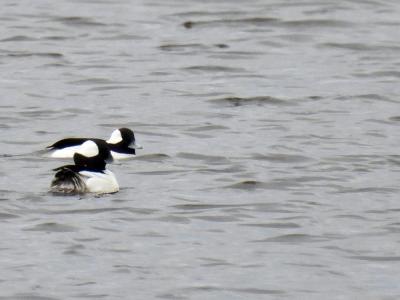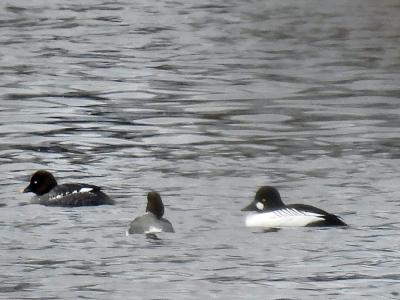January Thaw Impacts Lloyd Center Estuarine Winter Waterfowl Survey
One year ago, the second count (the winter portion) for the Lloyd Center Winter Waterfowl Survey was postponed a week by a blizzard, remnant snow and ice blanketing the landscape. Birds were searching for water, the perfect mixture of ice, snowy fields, and minimal open water, resulting in the highest Canada Geese and waterfowl totals in nearly two decades. This year the second count of the 36th annual survey occurred in contrast, after a mild stretch of weather and heavy rain events. While not affecting count day, which was stellar, with no wind and warm temperatures, rains created a soggy, green landscape, a rich food source for waterfowl that reduced their need for coastal systems that comprise this study area.
Overall results for this 2022/23 survey of 11,019 waterfowl included an even distribution of 5,000+ birds for each count, and little to no ice on systems for both counts, strikingly similar results to the 2017/18 season five years ago. That season, the winter count showed a considerable decline in Canada Geese, and less overall waterfowl than the fall count trends also observed for this season’s survey. For this count held on January 29, the 5,399 total waterfowl was a decline by 4,366 birds from a year ago, 90% of which were Canada Geese. The grand total was also a decline by 3,732, 87% of which also were accounted for with the Canada Geese decline.
In addition to the availability of freshwater ponds and forage in fields for geese, the heavy rains raised the water table, creating pools near ponds used by other species, including the locally common Mallards. At Buttonwood Pond in New Bedford, a relatively diverse waterfowl assemblage included 800+ geese and many mallards near the time of our survey, both species also using a nearby shallow pool created by rainfall, a feature sure present at other inland ponds. Water levels of some estuaries, including the Slocum which is fed by a freshwater creek, were also abnormally high, and a location where hundreds of Mallards normally winter had no birds.
However, the wintering Canada Goose population is immense, and some congregations in shallower portions of estuaries as expected, occurred. The largest (672) was in the upper East Branch of the Westport River, which also had large scaup and bufflehead concentrations. For entire sites other than the Westport River, Nannaquaket Pond in Rhode Island (667) had the most birds due to high numbers of Canada Geese and Bufflehead, and Allens Pond (618) was a close second with both Canada Geese (296) and the highest Black Duck (283) concentration. Briggs Marsh, nearly void of birds a year ago, also had a notably large flock of Canada Geese (414).
Of the dabblers, Mallards showed the steepest decline, followed by Black Ducks. While Mallards were mainly in freshwater, some Black Ducks might have been hidden in shallow coves due to high water levels. Divers showing subtle declines included Ring-necked Ducks, Hooded Mergansers, scaup (large flock of 120 in Nonquit Pond) and Common Goldeneye, relatively common species but which are somewhat more selective in the systems they inhabit.
There were subtle increases for many species, with our most common divers, Red-breasted Mergansers and Bufflehead, showing the highest increase of over 200 birds each. Highest Merganser abundance occurred at Round Pond (70), with small flocks observed at many other systems, while Bufflehead numbers were high but dispersed across sections on the Westport River East Branch (227), with the highest concentration being at Nannaquaket Pond (208).
Very small increases occurred for less common species including for dabblers, American Wigeon, Gadwall, and Northern Pintail, and for divers Common Eider, Ruddy Duck, and Long-tailed Ducks. Notable sightings included a flock (23) of Green-winged Teal in Allens Pond for a species historically more prevalent in the December count, and the return of the Redhead, an uncommon diver spotted in Cockeast Pond in December and which returned for this count.
We thank our volunteers for their help in this ongoing survey and look forward to next season!
by Lloyd Center Research Associate Jamie Bogart














